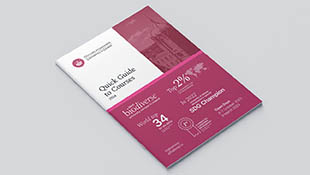-
Courses

Courses
Choosing a course is one of the most important decisions you'll ever make! View our courses and see what our students and lecturers have to say about the courses you are interested in at the links below.
-
University Life

University Life
Each year more than 4,000 choose University of Galway as their University of choice. Find out what life at University of Galway is all about here.
-
About University of Galway

About University of Galway
Since 1845, University of Galway has been sharing the highest quality teaching and research with Ireland and the world. Find out what makes our University so special – from our distinguished history to the latest news and campus developments.
-
Colleges & Schools

Colleges & Schools
University of Galway has earned international recognition as a research-led university with a commitment to top quality teaching across a range of key areas of expertise.
-
Research & Innovation

Research & Innovation
University of Galway’s vibrant research community take on some of the most pressing challenges of our times.
-
Business & Industry

Guiding Breakthrough Research at University of Galway
We explore and facilitate commercial opportunities for the research community at University of Galway, as well as facilitating industry partnership.
-
Alumni & Friends

Alumni & Friends
There are 128,000 University of Galway alumni worldwide. Stay connected to your alumni community! Join our social networks and update your details online.
-
Community Engagement

Community Engagement
At University of Galway, we believe that the best learning takes place when you apply what you learn in a real world context. That's why many of our courses include work placements or community projects.
Knocknarea: the archaeology of a mountain
Stefan Bergh
The mountain of Knocknarea on the Cuil Irra peninsula west of the modern town of Sligo forms an eye-catching landmark along this stretch of the Sligo coast. The smooth skyline of the mountain is conspicuously interrupted by the huge un-opened passage tomb cairn of Miosgan Meadhbha, the legendary burial place of Queen Maeve.
The Cuil Irra peninsula was a major ritual centre in the 4th millennium BC, and formed together with Bru na Boinne, Loughcrew and Carrowkeel-Keashcorran one of the four large ritual landscapes within the Irish Passage Tomb tradition. The c. 50 remaining passage tombs on the peninsula and in its hinterland bear witness of the intense ritual activity that once existed here.
The Knocknarea Archaeological Project was initiated in the late 1990s and its overarching aim has been to understand the role the mountain would have played in the ritual and secular lives of people in the Neolithic.
The archaeological remains on the mountain belonging to the Neolithic period consist mainly of a series of passage tombs, round house foundations as well as a complex series of banks along the upper eastern slopes. The presence of barrows, enclosures, rectangular house foundations as well as more ephemeral remains indicates that the mountain was continuously used for various purposes all through prehistory and medieval times up to the present day.
The field element of the project has involved detailed recording of the archaeology on the mountain, but also a series of focused excavations of selected sites over the years.
The completely unexpected discovery of an extensive and complex system of Neolithic banks, measuring some 2.5km in total length, along the eastern slopes forced a complete re-interpretation of the activity on the mountain. Finds from the banks indicated that they had been the focus for large scale lithic production using the locally available chert. The hollow scraper completely dominated the retouched tools, even though a more or less full range of Neolithic artefacts was present.
A series of C14 dates from various contexts along the banks firmly dates them to c. 3350 cal. BC.
Four of the in all c. 15 round house foundations on the mountain have to date been excavated. The finds in these houses correspond to those recorded along the nearby banks and a similar date for the houses can be assumed.
Among the remains from later periods, a group of in all four rectangular house foundations were recorded on a narrow ledge on the steep northern slopes. The top soil was removed at one of the house foundations, to facilitate the production of an plan of the site. No finds where made and the cluster of in all four buildings remain undated. A preliminary date to the late medieval period may however be suggested, based on building techniques and layout.
Funding
STINT (Swedish Foundation for International Cooperation in Research and Education)
The Irish Research Council
The Heritage Council
The Royal Irish Academy
Related Publications
Bergh, S. 2000 ‘Transforming Knocknarea – The Archaeology of a Mountain,’ Archaeology Ireland 14 (2), 14 – 18.
Bergh, S. 2000 ’Knocknarea Mountain: Neolithic Hut Sites and Bank’, Excavations 1999: Summary Accounts of Archaeological Excavations in Ireland, ed. I. Bennett, Bray: Wordwell, 277 – 278.
Bergh, S. 2002. ‘Knocknarea – the ultimate monument. Megaliths and mountains in Neolithic Cúil Irra, north-west Ireland’. In C. Scarre (ed.) Monuments and Landscape in Atlantic Europe. London: Routledge, 139 – 151.
Bergh, S. 2002. ‘Death in Sight – Knocknarea and the identity of Neolithic Cuil Irra, NW Ireland’. (abstract of paper presented). In G. Burenhult (ed.) 2003. Stones and Bones. Formal disposal of the dead in Atlantic Europe during the Mesolithic-Neolithic interface 6000-3000 BC. British Archaeological Reports International Series 1201, 271.
Bergh, S. 2002. Monuments of Meaning. Role of symbolism of Passage tombs in Cùil Irra, Co. Sligo. In M. Timoney (ed.) A Celebration of Sligo. First essays for Sligo Field Club. Sligo: Sligo Field Club, 65-72.
Bergh, S. 2003. ‘Two stones make a line’. In J. Fenwick (ed.) Lost and Found. Discovering Ireland’s past. Bray: Wordwell Ltd., 51-64.
Bergh, S. 2009. ‘Black is the Colour. Chert, concave scrapers and passage tombs’. In G. Cooney, B. O'Connor and J. Chapman (eds.), Materialitas: working stone, carving identity. Prehistoric Society Research Papers 3. Oxford: The Prehistoric Society and Oxbow Books, 105-112.


















